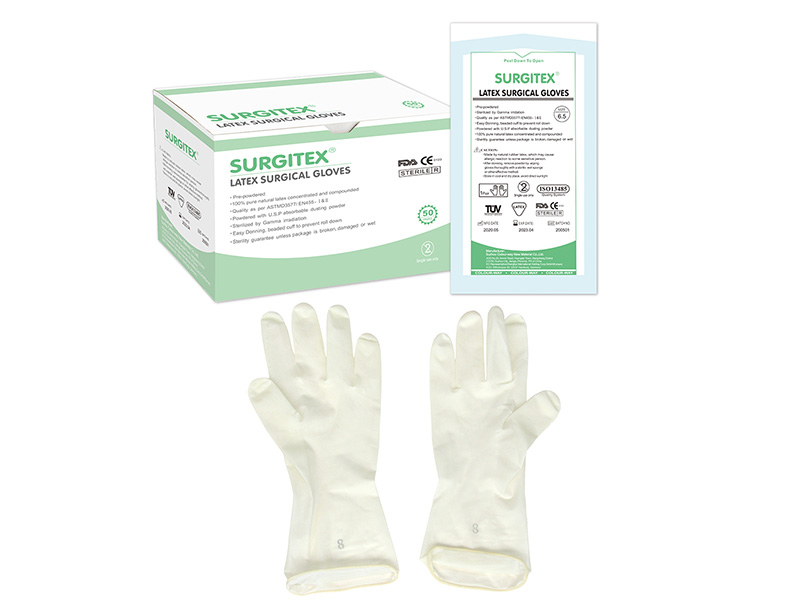Why should doctor wear sterilized latex surgical gloves?
Why should doctor wear sterilized latex surgical gloves?
The unhygienic "evil" hand reminds us to wash our hands correctly and wear sterilized latex surgical gloves. Some people wonder: since they wash their hands, why do medical staff wear gloves?
This is because hand washing is a short-term action. Although correct hand washing can reduce 90% of the bacteria in the hands, the hands of medical staff are vulnerable to the infection of temporary bacteria. Each operation may increase 100-1000 bacteria in the hands. In particular, the nosocomial infection in ICU is higher than that in ordinary wards, and its infection link is complex. The hands of medical staff, including nursing workers, have the highest probability of contact with critically ill patients in the process of diagnosis, treatment and nursing.
It is reported in the literature that in the general nursing operation, the amount of bacterial contamination in the hand is generally (103-105) cfu / C ㎡; When the work is busy, the amount of bacteria in the hands increases exponentially. The amount of bacteria in the hands of nurses sucking sputum for patients reaches 106 CFU / C ㎡, and the amount of bacteria in the hands of patients cleaning perineum is more than 1010 CFU / C ㎡. When medical staff contact patients or do not wash their hands after pollution, the exceeding standard rate of the total number of bacteria is 100%, and the carrying rate of gram-negative bacilli in ICU staff can reach more than 80%.
A large number of data show that maintaining hand hygiene is the most basic, simple and effective means to effectively prevent and control the spread of pathogens and reduce the incidence of nosocomial infection. In order to keep hands clean for a long time, it is necessary to wear sterilized latex surgical gloves.
Wearing sterilized latex surgical gloves can not only reduce the chance of patients infected with germs, but also ensure the health of medical staff themselves. It can even be said that wearing gloves can reduce the chance of medical staff's family members and friends contacting germs. Because medical staff carry drug-resistant bacteria without gloves, bacteria will cross parasitize among patients through contact with medical staff's hands, resulting in the spread of drug-resistant strains. Thus, it is spread again among communities (i.e. contacts) through the transfer of host patients. Therefore, medical staff wear gloves mainly to prevent the spread of bacteria, so as to protect patients, themselves and other contacts.
Sterilized latex surgical gloves have a certain service life. During the general operation, gloves need to be replaced once more than 90 minutes to prevent gloves from being damaged. However, gloves need to be replaced immediately when:
1. After completing the patient's examination, develop the habit of discarding gloves and change the habit of wearing gloves to touch computers, mobile phones, documents, etc.
2. If the gloves come into contact with places that may be contaminated by pathogens, it is recommended to replace a pair of clean gloves for operation if subsequent inspection or contact with clean places is required.
3. When the gloves come into contact with the patient's blood or body fluid, the gloves need to be replaced immediately in order to avoid cross infection with the subsequent patients. Timely replacement of sterilized latex surgical gloves seems to be a small move, but it can effectively reduce the incidence rate of infectious diseases, and it is also related to the health of doctors and patients.

How to wear sterilized latex surgical gloves correctly?
The correct use of sterilized latex surgical gloves by medical staff is not only to protect themselves, but also to ensure the safety and responsibility of patients. How can medical staff wear gloves correctly? This is a knowledge.
1. Glove wearing method
Hold the inner surface of the reverse folding part of the glove with your right hand, take out a pair of gloves, put your left hand into the left glove first, put your left hand into the outer circle of the reverse folding part of your right hand after wearing gloves, and then put your right hand into the glove (you can wear the right glove first). Pull the folded part of the glove over the cuff without exposing the wrist. Before wearing gloves, hands cannot touch the outside of gloves, and after wearing gloves, hands cannot touch skin.
2. Wear double gloves
Wearing double gloves can reduce the risk exposure of the wearer. If it is necessary to wear double gloves in specific operations (such as chemotherapy and bone marrow puncture), loose gloves are required so that one can be put on the other.
3. Replace gloves in time
After touching the suspected contaminated area or object of the same patient, the gloves should be replaced before touching the mucous membrane. Before contact with non pollutants or disposal of other patients, you should take off your gloves, wash your hands immediately or wash with disinfectant to avoid spreading microorganisms to other patients or objects.
4. Time to wear gloves
The longer you wear gloves, the more likely the protective barrier is to be damaged.
5. Remove gloves
During use, the infection source will pollute the outer surface of the gloves. It is very important to take off the gloves correctly. When taking off the gloves, do not pull them forcibly. Turn over the gloves and take them off gently. Try not to touch the outside of the gloves. The removed gloves should be disinfected in time rather than thrown into the waste bucket. Wrong removal of gloves may lead to the spread of pollutants outside the gloves. At this time, the best barrier function is meaningless.



